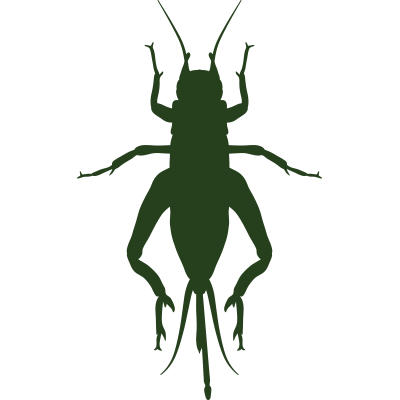
Scorpions
Scorpions are the most common pest that we eliminate. They are a predatory arachnid that has pinchers in the front and a curled tail with a stinger in the back. Their sizes can range from 9mm (.3 in) to 23mm or 9 inches. They hunt by waiting until their prey comes within striking distance of their tail. They grab their lunch with their pinchers and use their stinger to inject venom into their soon-to-be meal. Unfortunately, they will sting a human if it's close enough. Besides severe pain in the general area of a sting, a scorpion sting also tends to cause intense tingling, numbness, blurry vision, nausea, and muscle twitching that can last from one to three days. Although there are 30 or so species of scorpions found here in Arizona, the three most common are the Bark, the Striped Tail (or Devil Scorpion), and the Giant (or Desert Hairy Scorpion.)
Arizona Bark Scorpion
With being Arizona's most common scorpion, it's fairly easy to identify an Arizona Bark Scorpion. They are tan with yellow little lines running horizontal along their back and can range from 2.5 to 3.1 inches long. Meaning that they are VERY easy to step on which you do NOT want to do. They will not hesitate to give you a not-so-nice little poke with their venomous stinger. They are considered to be fatal to infants, sick, and elderly human. Another way to identify a bark scorpion is by its tail's position. They lay their tails parallel to the surface that they're laying waiting for prey. Arizona Bark Scorpions are unique because they can climb just about any surface that's slightly rough. Bark Scorpions are often found "hanging out" upside down on ceilings and on walls. They prefer cooler and moist areas as opposed to other scorpions who prefer the dryness of the desert.
Striped Tail Scorpion
The next most common scorpion found in Arizona is the Striped Tail Scorpion (Centruroides vittatus) or also known as the Devil Scorpion. It has similar colorations to the Arizona Bark Scorpion, but also has darker stripes running vertical along it's back in conjunction with the yellow lines running vertical. Though a sting from the Striped Tail Scorpion is not typically considered deadly, it can cause extreme pain, numbness, tingling, increased heart rate and muscle twitching. Striped Tail Scorpions are often found crawling along the ground under rocks and debris so be careful the next time you're moving stuff around in your backyard.
Giant Desert Hairy Scorpion
The Giant Desert Hairy Scorpion (Hadrurus arizonensis) also know as Giant Hairy Scorpion and Arizona Desert Hairy Scorpion is Arizona's least common scorpion. The Giant Hairy Scorpion is the only scorpion of the Hadrurus family that can be found in the Sonoran and Mojave desert. Although it is a burrowing scorpion, it can also be found under rocks and debris in the desert and yard. Even though people compare the sting of a Giant Desert Hairy Scorpion to that of a honeybee, it can still be fatal if an allergic reaction occurs.
Spiders
Spiders are 8 legged, venomous arthropods. Although all spiders are venomous, only 1% of all the different species on earth are considered dangerous to humans. Have you ever heard of arachnophobia? Of course you have. Just over 30% of everybody that lives in the United States claim to have arachnophobia. There are 21 species of spiders that call Arizona "Home." Of which only 2 are considered deadly; the black widow and the desert recluse. We provide precise applications of eco-friendly pesticides so that you can enjoy your home again without coming across a creature of your nightmares.
7 Common Species That You May Find In Phoenix
Black Widow
The western black widow (Latrodectus hesperus) is a venomous spider species found in western North America. They are one of the two spiders found in Arizona that are considered deadly. However, it is only the female's bite that is considered to be deadly. If you were to be bit by a female black widow you could expect the following symptoms; muscle cramps and spasms, sweating, chills, fever, nausea, severe torso and back pain, headache, high blood pressure, and rarely seizures. A male's bite usually doesn't require medical treatment and you can identify the two easily by their color configurations. A female Black Widow is black with what is usually a red, occasionally yellow, and rarely white hourglass shape underneath it's abdomen. A male Black Widow is normally tan with a lighter stripe on the abdomen.
Desert Recluse
The desert recluse (Loxosceles deserta) is often misidentified as the brown recluse that is found in the southern and midwestern United States. It is one of the two potentially deadly spiders that can be found in Arizona. They are a little bit harder to identify than a Black Widow. The desert recluse is usually tan with a violin shape on its back. Symptoms of a desert or brown recluse bite include; pain, itching, reddened skin, blisters, an ulcer follow by necrosis. If you think that you have been bitten, seek medical attention as soon as possible.
Tarantula
Ahh, yes, the tarantula. The epitome of arachnophobia. Arizona is home to few species of tarantulas but the Western Desert Blond Tarantula (Aphonopelma chalcodes) is the most common and is often referred to as the Arizona Blond Tarantula. They are extremely easy to identify. They are tan or brown and range from 70-100mm in size. They have lots of hairs all over them that they will shoot out if threatened, but in reality, they're actually virtually harmless to humans and are known to be incredibly docile. If bitten you generally do not need to seek medical attention unless other symptoms such as nausea or muscle twitching occur and last for more than a day. Males can live up to 17 years old and females can live up to twice as long.
Giant Crab Spider
The Giant Crab Spider (Olios giganteus) or also known as the Golden Huntsman spider is one of the largest that can be found throughout the Sonoran desert in Arizona. They can range from 11-48mm in size and bites from giant crab spiders are rarely fatal to healthy humans. Instead of using webs to catch their prey, they actually use speed and strength to subdue their next meal.
Jumping Spider
The Jumping Spider is from the family (Salticidae) and of which their are more than 6,500 species of Jumping Spiders in the world. Although only 2 of those 6,500 species are common in Arizona, they are still one of the most common spiders found in this beautiful state. They have 4 pairs of eyes and the frontmost pair are exceptionally large in size. They are named the jumping spider because they do just that. If threatened or are ready to attack prey, they will make an agile leap from their threat or their next meal.
Black And Yellow Garden Spider
The Black and Yellow Garden Spider (Argiope aurantia) often referred to as the Yellow or Golden Garden Spider. These are an extremely common species found in the United States, Canada, and Mexico. They have distinctive black and yellow markings on their bodies and range from 5-28mm. They may bite if harassed but the venom is absolutely harmless to humans. The yellow garden spider likes to build its webs adjacent to open sunny fields to avoid the wind. You can also find their webs on tall vegetation and along eaves of houses.
Wolf Spider
Wolf spiders are from the family (Lycosidae) and there are over 2,300 species in the world. Of those 2,300 species there are only 200 or so live throughout the United States. Wolf Spiders range from 10-35mm in size and though are venomous like most spiders, they are not considered lethal to humans. Wolf spiders get their name because they were thought to hunt like wolves, but they don't actually hunt in packs so they're more like lions.
Bees
Insects in this category–bees, hornets, wasps, and yellow jackets–are all flying stinging bugs. Some are good for your environment and others are extremely harmful to not only the environment but your safety. It is important to consult a professional before attempting to remove any of these insects, as they may attack if their nests or hives are disturbed. All feral bees in Arizona are considered to be africanized. On average 7 people die each year from spider bites but 8 times as many die from Bee and Wasp stings. They can hurt or even kill you so please, if you have a Bee problem at your home or place of business, call Peep's Pest Control for speedy and complete removal. As you can see, these are not your average Bees that we are dealing with. On average 7 people die each year from spider bites but 8 times as many die from Bee and Wasp stings. We cannot stress enough that this is not a can of Bee spray kind of job. These Bees will hurt or kill you so please, if you have a Bee problem at your home or place of business, call Peep's Pest Control for speedy and complete removal. All feral bees in Arizona are considered to be africanized.
Ants
There are more than 12,000 distinct types of ants on the planet. Ants are related to honey bees and wasps. Ants are subterranean insect settlements go in size from a couple of dozen to millions. Like wasps and honey bees, ants shape an unmistakable rank system, in which each kind of insect fills a particular part to bolster the colony. They are known to come into your brand new Queen Creek House in search of crumbs and food. Some ants like Fire Ants and Red Ants can bite and cause itchy sores on your body. The best way to keep ants from invading your house is by calling a professional Ant Removal Expert in San Tan Valley.
Cockroaches
There are four common types of cockroaches found in Arizona: the German Cockroach, American Cockroach, Turkestan Cockroach, Brown Banded Cockroach. Cockroaches in a residential or commercial environment are considered a health hazard as they can cause asthma flare ups and carry disease causing germs. Cockroaches defecate and regurgitate upon the food that they eat which spreads any bacteria or parasite that they host. They are also considered a health hazard due to the many over-the-counter products people use to try to get rid of an infestation with. We at Peep's Pest Control here in San Tan Valley design our Cockroach program around you and use only family and eco-friendly pesticides to counter any Cockroach problem you may have.
Crickets
There are 3 types of Crickets commonly found here in Arizona. We have the House Cricket, the Tropical House Cricket and the Field Cricket. Though some people find their chirping to be pleasant and Crickets are harmless to humans, they are food for Scorpions and Spiders. So if you have crickets, it won't be long until the bugs that are harmful find their way into your home or business. Here at Peep's Pest Control, we exterminate and remove crickets from homes and businesses in San Tan Valley, Queen Creek, Mesa, Chandler, Gilbert, Tempe, and Florence so give us a call!
House Flies
House flies represent around 91% of all flies in human homes and are discovered everywhere throughout the world. These bugs are not only an irritation, but carry over 100 various types of disease causing germs! These troublesome little buggers get their name from being the most widely recognized flies around houses. The entire life-cycle of a house fly takes from 10 to 25 days, but it feels like they're in your home until the end of time! House Flies only eat.... or drink fluids, however have a capacity to transform solids into liquids! Houseflies taste and discover sugar with their feet, which are 10 MILLION times more sensitive than human tongues. House Flies more often than not remain with in 1-2 miles from where they were conceived, But they have relocated up to 20 miles looking for nourishment!
Fly Removal Tip
Destroying the environment that flies flourish the most in is the most ideal approach to stop an infestation. This implies honing great sanitation and keeping trash can lids closed. Keeping window sills seals, having a screen in place on your sliding glass door. If this doesn't work, you can call San Tan Valley's favorite pest control company - Peep's Pest Control!
Fleas
Fleas are an pest that many pet and home owners have likely dealt with at one point in time. Since numerous types of fleas like to make a meal of animal's blood, pets are the most widely recognized method for Fleas to infest your household. Despite the fact that Fleas like cats and dogs, once inside a home they will regularly turn you into a meal as well.
A grown-up Flea is a dark red colored bug that is relatively skinny. This means that the bug is not wide that way it can move more effortlessly between the hairs of pets. Fleas also have little spines on their body's that keep them from being wiped off of the host. Furthermore, a Flea has a hard external body that keeps it from being crushed. In view of these adjustments, it can be hard to get rid of them. For proper flea removal, don't hesitate to give a call to San Tan Valley's best pest control company-Peep's Pest Control.
Ticks
Ticks are 8-legged creatures like scorpions and spiders but when they creep into the crevices and slits, they can imbed themselves into the pores of a cement, crawl underneath the siding of a home, behind the splits and crevices that exist in a stucco, or anyplace that they can effectively brood. Effective tick control requires treatment of both the Tick and the environment that the insect resides.
Ticks are sly; they breed to a great degree productively. The sort of tick that we encounter mostly in Arizona is known as the brown dog tick; it is an ectoparasite. It hops on the dog, eats lunch, hops off and climbs into a split or crack. Inside the splits or cracks the tick sheds its shell, and becomes bigger. The Brown Dog Tick proceeds with jumping on the dog, feeding, then hopping off and shedding until it has achieved the phase in its life when it reproduce. The Brown dog Tick can lay 250 to 5000 eggs at any given moment, making the tick exceptionally hard to control. For best results of Tick Removal in Florence Arizona, give Peep's Pest Control a call!
Bed Bugs
Bed Bug bites, though not dangerous to humans, represent a place where the bug has bitten you in order to feed on your blood. They will occasionally do this for many minutes at a time. This can lead to itching and scratching which in turn can lead to lesions and infection. Bed Bugs can sometimes go longer than a year between feedings.
If you travel or just sit on an infested piece of furniture they can attach themselves to your clothing or luggage and hitch a ride back to what you thought was your cozy pest free home in the Eastern Phoenix Valley. A female Bed Bug can produce between 200 and 250 eggs in her lifetime and once these eggs hatch the nymphs will all be looking for a meal (on you) You can prevent and eradicate a Bed Bug problem with a quick call to Peep's Pest Control!
How we work
Step 1 - Call and schedule a visit
So you're stressed about all of those intruders that you just discovered in your Queen Creek house huh? Hiring us is as easy as it gets. Give us a call or send us an email. We will work with you to find the best time to schedule a treatment or pest removal. It really is that easy. No contracts. No strict scheduling policy. Just call and put your mind at ease.
Step 2 - Enjoy a pest free life
We firmly believe that you should be able to go to bed at night without having to worry about a spider dropping down onto your face while you sleep or a scorpion hiding underneath your refrigerator. Not only will we remove your pests but we offer free callbacks. If your pest problem has not vanished within 1 month of hiring us, we'll be right back there for a free 2nd treatment.
We Can Help.





















